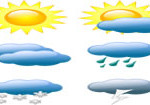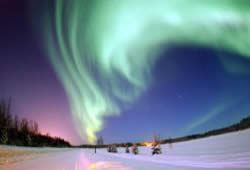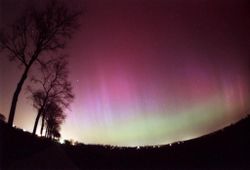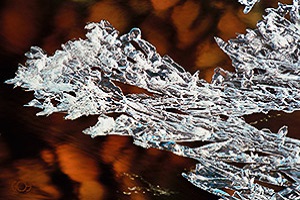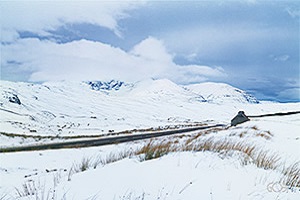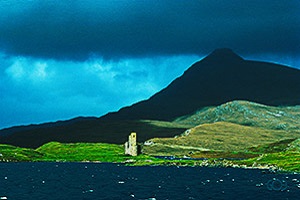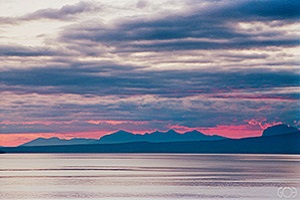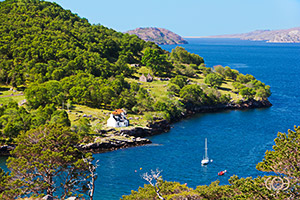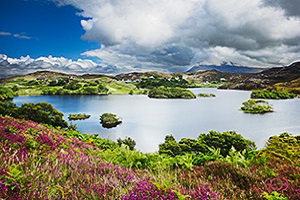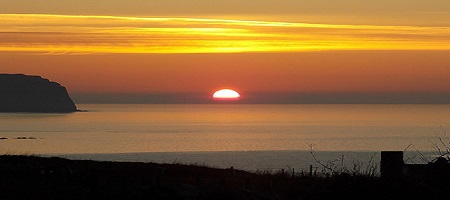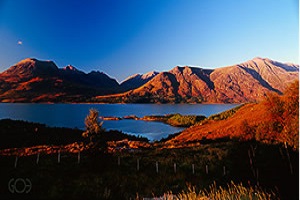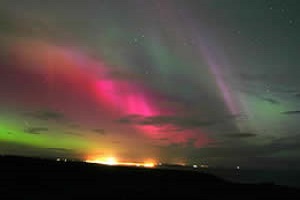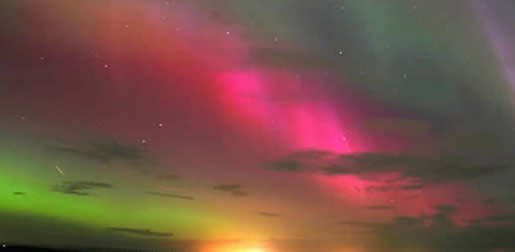Scotland’s Weather Forecast
A brief overview of the annual Weather in Scotland, general Weather forecasts and links to accurate Weather forecasts.
A Brief Annual Summary
It is a popular held belief that Scotland’s weather is poor, however you may well be surprised to hear, the moderating effects of the Gulf stream mean that it is not as cold as you would expect given Scotland’s high latitude. The east tends to be colder in winter and warmer in the summer; frost in winter is surprisingly rare on the west coast. Snow or sleet falls less than 30 days per year and rarely lies around the coastal areas, the surrounding Ocean warms the air, the mean minimum temperature in winter is well above freezing. Sea temperature averages out at 13° and in winter it gets no lower than 9°C. Perfect for water sports. White sandy beaches sparkle and outshine tropical shores.
Scotland’s beaches are uncrowded, stunningly beautiful and perfectly clean, five metre tides naturally wash the sands twice every single day. Scotland’s position on the edge of the European continent with sea on three sides means that the weather is very varied. Records show that May and June are usually drier than July and August the annual rainfall is only slightly greater than London’s and many of the east coast towns have less annual rainfall than Rome.
Generally speaking, the east coast tends to be cool and dry, the west coast milder and wetter. July and August are normally the warmest months, average temperature of 15-19oC/60-68oF. But the exact forecast for Scotland’s weather depends on the wind direction and exactly where you are. Westerlies mean mild and wet on the west side and mild and not so wet on the east. North is cold and south is warm. East means warm and sunny on the west and damp and cold on the east coast.
Which is why Scotland’s advanced weather forecast’s and actual real time reporting is consistently inaccurate. Indeed the Northern Highlands and Islands of Scotland have consistently seen Warmer, Dryer Summer Weather than that of England and Wales between May and the end of August over the last 5 years.
From John o’ Groats & Cape Wrath down to the Cheviot Hills in the Scottish Borders Scotland is packed with Forest Parks, Mountains, Glens, Lochs and some of Europe’s finest Sandy Beaches and Inlets, Choose Quality Holiday Accommodation from Lodges, Woodland Cabins, Seaside Chalets, Loch side Chalets, Countryside Cottages to Remote Highland Cottages to Launch your Activity Holiday in Scotland.
 “Over the last 5 years many parts of the Northern Highlands and Hebrides Islands enjoyed 86 days of unbroken sunshine and average temperatures of 22°
“Over the last 5 years many parts of the Northern Highlands and Hebrides Islands enjoyed 86 days of unbroken sunshine and average temperatures of 22°
The Best Scottish Sun Spots over the last few years have been
The Northern Scottish Coastlines Wester Ross and Ross-shire Isle of Skye and the Western Isles
Scotland also does not suffer the oppressive heat found in cities and in the south of England: while daily maximum summer temperatures in London frequently exceed 30°C, we nestle around a comfortable 16 – 20°C. Perfect temperatures for all sorts of outdoor activities.
Windy weather is beautiful: particularly in December and January the mean monthly wind speeds are 16 knots (18 mph) and storms are not uncommon
The Northern Lights in Scotland “Is caused by unusual Weather Conditions” Click here for much more information
Scottish Weather in the Winter Scottish Weather in the Spring Scottish Weather in the Summer Scottish Weather in the Autumn
The Scottish Weather in the Winter
Photo © http://www.gordon-c-harrison.co.uk
Winter weather can be wild, yet with the correct location you can enjoy the most exhilarating views in total comfort. Take Dunnet head, Britain’s most Northerly point. Imagine yourself in the comfort of a fully heated cottage double glazed with thick stone walls and sitting in a cosy conservatory watching the sight of 30 foot waves crashing over 20 foot cliffs right in front of your eyes.
Or perhaps the peace and tranquillity offered inland from the comfort of a Cosy Log Cabin in Argyll. As you become absorbed in a good book you take a look out of the window and see snow fall around your Argyll Log Cabin, you then look a little further and see snow covered mountains assuming a more “arctic and alpine” character reflecting onto the Loch.
The beautiful peace and tranquillity is broken occasionally with the sound of snow falling from the roof and the sweet song of the bird.
If you want to see the dramatic side and be in awe of the magnificence of nature, Why not come to the Isle of Skye in the winter. You won’t be disappointed and when it’s not stormy you’ll be treated to a beautiful Island Holiday Cottage bathed in the calm, still light of crisp, fresh winter weather.
Take care to choose the correct location for your holiday and prepare with the correct clothing and winter can be as enjoyable as any other season. A clear bright day in winter can inspire and refresh even the most jaded heart and in the evenings don’t forget the Northern lights in Scotland “Aurora Borealis”.
With good timing you have the opportunity of experiencing one of the world’s most magnificent natural phenomena: the Northern Lights. The Northern night sky dancing with red, yellow, green, blue and violet streamers, arcs and rays. The best place to see the Northern lights are in the more Remote Detached Scottish Cottage locations and the best time in the winter months on cold crisp clear nights between 10 pm and 3 am.
If you don’t see the Northern Lights, then at least you’ll see the stars – many, many more than you’ll see from anywhere less remote. The longer you look up, the more stars will appear!
But do wrap up and enjoy nature in the raw, or finish the year with a toast to your next visit at one of our many hogmanay parties.
Scottish Weather in the Winter Scottish Weather in the Spring Scottish Weather in the Summer Scottish Weather in the Autumn
The Scottish Weather in the Spring
Photo © http://www.gordon-c-harrison.co.uk
The season of snow capped mountains, cascading waterfalls and flowering shrubs, is generally the best time to sample dry warm weather….and a total absence of midges. Stay inland in a Western Highland Log Cabin and you will be treated to very pleasant, almost tropical weather from the middle of March. Stay around the coastlines particularly the Self Catering in the Northern highlands and you will be greeted with gentle warm gulf stream breezes, longer evenings, spectacular red sunsets and early morning sun rises.
The Isle of Skye gets an average of 201 hours of sunshine in May, but only 125 hours in July. On the east coast however, June and July tend to be the sunnier months.
All along the coast of Scotland, spring is heralded by the frantic trilling of the sky lark as it soars into the sky announcing the end of winter. For many this is the first intimation of better weather on the way. For others the buds on the birch trees and songs of early migrant birds, enjoying the first warmth of the sun is the sign.
What will the Scottish weather be like Today – or over the next week ?
The Weather forecast Live from the BBC
Scottish Weather in the Winter Scottish Weather in the Spring Scottish Weather in the Summer Scottish Weather in the Autumn
The Scottish Weather in the Summer
Photo © http://www.gordon-c-harrison.co.uk
Scotland will always be all things to all people because it offers everything to everyone and because of this….do take care to select your holiday destination well in advance to avoid any possible disappointment, choose from Argyll Lochside Cabins, Cottages by the sea, mountains and Islands
Scotland does not suffer the oppressive heat found in cities and in the south of England: while daily maximum summer temperatures in London frequently exceed 30°C, we nestle around a comfortable 16 – 21°C. Perfect temperatures for all sorts of outdoor activities.
The long summer days give you more time to enjoy yourself. In the Caithness area the midsummer sun rises from 3.30am and sets about 11pm. The summer sunsets on North West Skye are simply Amazing
A typical Isle of Skye Sunset – Click for a Cottage on Skye to enjoy this
Step back in time and visit some of Scotland’s historic sites and buildings. Walk through the Gardens and glens in Argyll, part of the West highland way or the Isle of Skye Cuillin hills, or why not tee off for a round of at midnight as is the tradition on the Far North Coast of Scotland on the longest day in June.
Awaken your senses while exploring some of our spectacular gardens. Follow the trails through the Scots Pine forests, such as those in Wester Ross and the Cairngorms.
Scottish Weather in the Winter Scottish Weather in the Spring Scottish Weather in the Summer Scottish Weather in the Autumn
The Scottish Weather in the Autumn
Photo © http://www.gordon-c-harrison.co.uk
Scotland passes from long summer evenings and settled weather into the less predictable but glorious autumn season. The birches, rowans and bracken bring a riot of yellow and red to the glens and hillsides. Wherever you visit you will be rewarded with breathtaking colours particularly in Argyll and Wester Ross where you can relax in Luxury and comfort and enjoy panoramic views of Lochs and mountains while taking in the most wonderful mix of late Autumn colours.
The moorlands and peat lands offer a colorful display in autumn as the hillsides turn a golden brown, seen best at the end of the day with low sunlight showing up every hump and hollow so vividly that you’ll have to stop for a photograph. Now is the time to really hear the rutting deer and unmistakable roar of the stag.
Move out to the coast and you are greeted by warm gulf stream breezes, fiery sunsets reflecting off the ocean and of course the Northern lights “Aurora Borealis”. With good timing you have a good chance of experiencing one of the world’s most magnificent natural phenomena: The Northern night sky dancing with red, yellow, green, blue and violet streamers, arcs and rays. The best time to see the Northern lights is in the winter months and late Autumn between 10 pm and 3 am. The best locations to see the Northern Lights are the remote areas and particularly the Far North of Scotland.
If you don’t see the Northern Lights, then at least you’ll see the stars – many, many more than you’ll see from anywhere less remote. The longer you look up, the more stars will appear !
Really short of time and patience? Don’t have time to telephone and browse this site further now?
Then please complete this short enquiry form below and we will e-mail you a FREE list of all available Self Catering Holidays in Scotland. Including hire rates, direct website links and booking information.
